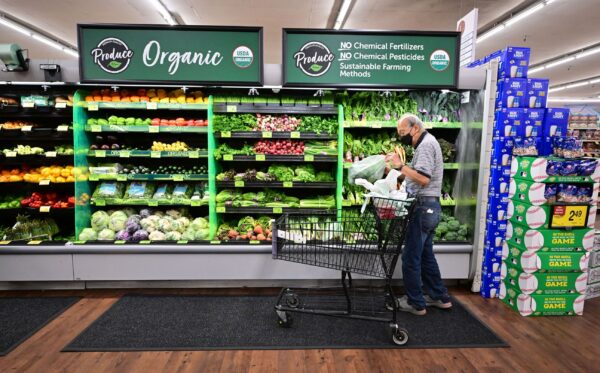Spike in Egg, Lettuce Prices Shows Supermarket Prices Still Hurting Budgets
The U.S. annual food inflation rate slowed to a seven-month low of 10.4 percent in December, down from 10.6 percent in November, according to the Bureau of Labor Statistics (BLS).
Household grocery budgets still face tremendous pressure as supermarket prices remained elevated at 11.8 percent, and rose 0.2 percent month over month.
The Consumer Price Index (CPI) report showed that many kitchen staples continue to be much higher than they were a year ago. Other common food items are rising or falling at a sluggish pace.
The cost of eggs, for example, has captured national attention, with prices skyrocketing 59.9 percent year over year last month. From November to December, egg prices advanced 11.1 percent.
Egg farmers have faced a trifecta of problems over the last year.
The contagious and lethal highly pathogenic avian influenza (HPAI) has decimated supplies. When birds contract the avian flu, they must be slaughtered. As a result, approximately 43 million egg-laying hens have been killed. Experts say this is the deadliest outbreak in the nation’s history.

Meanwhile, diesel prices have surged substantially, rising about 29 percent from the year-ago period, according to the American Automobile Association (AAA). In June, the national average price for a gallon of diesel reached $5.81.
The sizable increase in animal feed has also added to input costs. Prices have eased from a year ago, but the latest data show that feed is up more than 4 percent.
“As the large populations of these newly industrialized countries demand more meat, the world prices for all inputs, including animal feed, have been pushed up,” IBIS World stated in a report. “The effect of oil prices on feed prices has increased significantly in the last decade due to the increased use of corn-based ethanol as a gasoline substitute and soybean-based biodiesel as a diesel fuel substitute.”
Lettuce has been another food item to witness a significant increase from a year ago, surging nearly 25 percent.
The challenges started in California last year when impatiens necrotic spot virus (INSV) began destroying acres of lettuce crops. Lettuce growers in the Salinas Valley project that they will suffer a yield loss of about 80 percent in 2022. The Golden State accounts for about half of the country’s lettuce output.
Butter has also become a luxury in this current market as prices have surged 31.4 percent year over year. Data from the Federal Reserve Bank of St. Louis confirm that the average cost per pound is $4.81.
One of the chief reasons for this has been the decline in milk production. Despite a substantial increase in production from February to May, output tumbled nearly 7 percent from June to November.
Like eggs, the cost of feed and persistent labor shortages has made buying and maintaining cows much more expensive for farmers in the last couple of years.
In addition, according to the U.S. Department of Agriculture (USDA), climate factors, such as floods and droughts, have “weighed on productivity growth.”
“Such conditions can affect the availability and quality of feed as well as the physiological functioning and reproductive health of dairy cows,” the USDA report stated. “Negative environmental conditions also lead to the distribution and resiliency of parasites and pathogens that affect animal health.”
Meanwhile, USDA figures show that butter cold-storage holdings were down about 8 percent in November from January.
A noteworthy finding in the BLS’ CPI report for December was the staggering 305.2 percent spike in prices for food at elementary and secondary schools. This, experts say, was caused by the expiration of the federal pandemic-era waivers for free school lunches.
How Are Consumers Coping?
Looking ahead to next year, food prices are expected to slow to 7.6 percent, according to the Federal Reserve Bank of New York’s Survey of Consumer Expectations. If accurate, it would be the lowest level since January 2022.
At a time when food prices are going through the roof, consumers are struggling to put groceries on the table.
According to a recent survey from Swiftly, a retail technology firm, 69 percent of shoppers struggle to pay their grocery bills. The poll also found that 74 percent adjusted their grocery shopping habits and 33 percent chose to shop in-store more than in previous years.
“Most consumers have been greatly impacted by inflation over the last two years, especially when it comes to food. Although more than three-quarters of consumers have changed their spending habits when it comes to buying food in response to these higher prices, food is still a necessity, not a luxury, and there is no avoiding at least some increase in food prices,” said EJ Antoni, a research fellow for regional economics in the Center for Data Analysis at The Heritage Foundation, in a report.
“Some families’ food budgets have been stretched so thin that a quarter of them only buy items when they are on sale,” he added. “It is not hyperbole to say that many Americans are living worse than their grandparents did in terms of food security.”
When real wages (inflation-adjusted) have been down for a record 21 consecutive months, effectively destroying thousands of dollars in purchasing power for the typical U.S. family, it might mean more affordability difficulties at the local supermarket.
While the U.S. annual inflation rate slowed to 6.5 percent in December, Peter Earle, an economist at the American Institute for Economic Research (AIER), warned of stickiness.
“One of the big fears you always have when you have an outbreak of inflation, and when we haven’t had one for 40 years, is that it rises pretty quickly and pretty easily gets sticky. And it gets sort of persistent and stubborn on the way down,” Earle told The Epoch Times. “Coming down, it’s gonna be a little bit slower.”
This might be the case for grocery bills in 2023.





